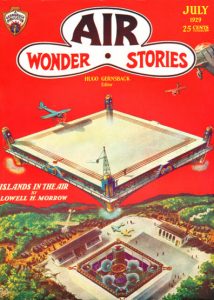 Imagine the delights of flying when airplanes were new. The excitement of air circuses, wing walkers, and barnstormers. Think of the brave flying aces whose tremendous feats of courage helped us win the Great War. This was the atmosphere ninety years ago when Hugo Gernsback launched AIR WONDER STORIES on June 12, 1929.
Imagine the delights of flying when airplanes were new. The excitement of air circuses, wing walkers, and barnstormers. Think of the brave flying aces whose tremendous feats of courage helped us win the Great War. This was the atmosphere ninety years ago when Hugo Gernsback launched AIR WONDER STORIES on June 12, 1929.
In truth, the accuracy of the stories’ science is soft, although there is real information about contemporary planes and flying in each issue. The Frank R. Paul covers show spectacular flying machines and cities, all of which seemed appropriately futuristic.
In June 1929 there were over a dozen air-oriented magazines available on the newsstands. Gernsback was riding a popular wave with AIR WONDER STORIES, a pulp that would tell “flying stories of the future, strictly along scientific-mechanical technical lines, full of adventure, exploration and achievement.”
But the magazine was short-lived, running briefly for eleven issues from July 1929 until May 1930. After this, it merged with SCIENCE WONDER STORIES to become, WONDER STORIES. During its short run Hugo Gernsback was editor-in-chief, David Lasser was listed as Literary Editor and Frank R. Paul, Art Director.
Each issue included a letters column, “News of Aviation,” an “Aviation Quiz,” and later, a column called “Aviation Forum,” which answered questions and explained general principles of powered flight.
The stories were a mix of new and old, with some reprints from Gernsback’s earlier magazines. Well-known writers such as Edmond Hamilton, Jack Williamson, Victor McClure, George Allan England, and Harl Vincent appeared in its pages.
The “News of Aviation” column speculated on the future of flight. In the first few issues we see articles about — giant airships planned for the United States Navy, the practicality of telephone service on airplanes, and quotes from the Graf Zeppelin director about how to make plane flights profitable. We also discover that a flight from New York to Siberia will soon take a mere five days by air. Also that, the Mayflower Fire and Marine Insurance Company will soon offer insurance policies against airplane crashes in suburban areas.
The first issue covered a variety of story topics including — robot flying machines, anti-gravity, and Eugenics. The latter is the central theme of “Men with Wings” by Leslie Stone, a pseudonym for a female writer named Leslie F. Silverberg née Rubenstein (1905-1991).
The September 1929 issue includes a letter of praise for the magazine from 14-year-old Henry Kuttner, enthusing about the stories in the premiere issue, specifically — “Ark of the Covenant,” “Islands of the Air,” and “Men with Wings” which he found to be “splendid.” It is in Gernsback’s response to Kuttner’s letter where we discover that Leslie Stone, is a woman, not a man, as Kuttner had assumed.
AIR WONDER STORIES filled a niche that we can barely imagine today. Our dreams have moved on and those old stories seem almost shocking in their limited scope. But, at the time, they spurred visions for readers, and upcoming authors such as Henry Kuttner, to build upon and create their own speculative dreams of the future.
(Sara Light-Waller is one of more than thirty fiction writers who will be attending PulpFest 2019. An avid reader of pulp science fiction stories, Sara writes and illustrates her fiction in the manner of the Golden Age science fiction from the 1930’s and 40’s. She is the author of ANCHOR: A STRANGE TALE OF TIME and LANDSCAPE OF DARKNESS.
Sara will be one of our “New Fictioneers” readers on Saturday, August 17, at PulpFest 2019.
The official release date of the July 1929 AIR WONDER STORIES — featuring cover art by Frank R. Paul — is thanks to Mike Ashley and Robert A. W. Lowndes, writing in THE GERNSBACK DAYS (2004).
The final issue of AIR WONDER STORIES was dated May 1930. There were a total of eleven issues. After AIR WONDER STORIES and SCIENCE WONDER STORIES were combined to form WONDER STORIES, the magazine had a run of seventy-eight issues. The final issue of WONDER STORIES was dated April 1936. The title was then sold to Standard Magazines. It returned to the stands as THRILLING WONDER STORIES during the summer of 1936.
For a brief look at the history of this classic pulp magazine and its various incarnations, please see our post, “The Sense of Wonder (Stories),” published on our website on May 5, 2014.)







